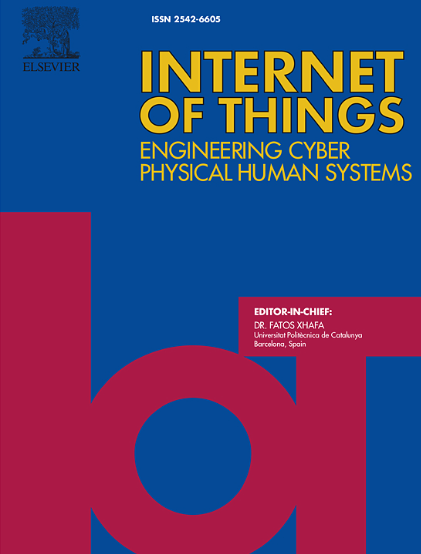2.4 GHz LoRa组网中的网关配置
IF 6
3区 计算机科学
Q1 COMPUTER SCIENCE, INFORMATION SYSTEMS
引用次数: 0
摘要
LoRa无线电技术最近已经扩展到2.4 GHz频谱,它提供了诸如增加带宽和全球规则兼容性等优势。2.4 GHz LoRa承诺更高的数据速率和吞吐量,这对数据密集型工业应用至关重要。它保持了远程通信和低功耗等关键功能,使其适合各种工业物联网(IoT)应用。然而,2.4 GHz网关面临着挑战,因为它们的设计限制,只需要一个扩频因子(SF)设置和信道分配给四个可用的收发器。这种设计限制了终端设备(ed)可以拥有的可用选项的数量,并导致资源分配问题。为此,本文提出了2.4 GHz LoRa网关的网关配置问题,主要目的是在终端设备之间提供能耗和公平性之间的权衡。引入了一个双目标优化问题,该问题通过考虑两个目标函数的凸组合来求解。利用λ∈[0,1]系数寻找两个目标之间的Pareto最优解。针对整数线性规划(ILP)方法的高计算复杂度,提出了两种计算成本较低的实用启发式方法。仿真结果表明,与网关静态配置相比,该方法具有更好的公平性和包接收率。此外,结果表明,λ能够提供公平和能源效率之间的权衡。在一个由16个ESP32器件组成的小型测试台上进行了实验,证实了这一发现。本文章由计算机程序翻译,如有差异,请以英文原文为准。
Gateway configuration in 2.4 GHz LoRa networks
The LoRa radio technology has been recently expanded into the 2.4 GHz spectrum, which offers advantages such as increased bandwidth and global regulation compatibility. 2.4 GHz LoRa promises higher data rates and throughput, crucial for data-intensive industrial applications. It maintains key features such as long-range communication and low power consumption, making it suitable for various industrial Internet of Things (IoT) applications. However, 2.4 GHz gateways face challenges due to their design limitations that require only one Spreading Factor (SF) setting and channel to be assigned to each of the four available transceivers. This design limits the number of available options that the end-devices (EDs) can have and leads to resource allocation problems. To this extent, this paper presents a gateway configuration problem for 2.4 GHz LoRa gateways, mainly aiming at providing a trade-off between energy consumption and fairness among end-devices. A bi-objective optimization problem is introduced, which is solved by considering a convex combination of two objective functions. A coefficient is employed to discover a Pareto optimal solution between the two objectives. Due to the high computational complexity of the integer linear programming (ILP) approach, two practical heuristics with lower computation costs are also proposed. Simulation results show that the proposed approaches exhibit better fairness and packet reception ratio (PRR) compared to the static configuration of gateways. Moreover, the results reveal that is capable of providing a trade-off between fairness and energy efficiency. The findings are confirmed by conducting experiments on a small-scale testbed consisting of 16 ESP32 devices.
求助全文
通过发布文献求助,成功后即可免费获取论文全文。
去求助
来源期刊

Internet of Things
Multiple-
CiteScore
3.60
自引率
5.10%
发文量
115
审稿时长
37 days
期刊介绍:
Internet of Things; Engineering Cyber Physical Human Systems is a comprehensive journal encouraging cross collaboration between researchers, engineers and practitioners in the field of IoT & Cyber Physical Human Systems. The journal offers a unique platform to exchange scientific information on the entire breadth of technology, science, and societal applications of the IoT.
The journal will place a high priority on timely publication, and provide a home for high quality.
Furthermore, IOT is interested in publishing topical Special Issues on any aspect of IOT.
 求助内容:
求助内容: 应助结果提醒方式:
应助结果提醒方式:


